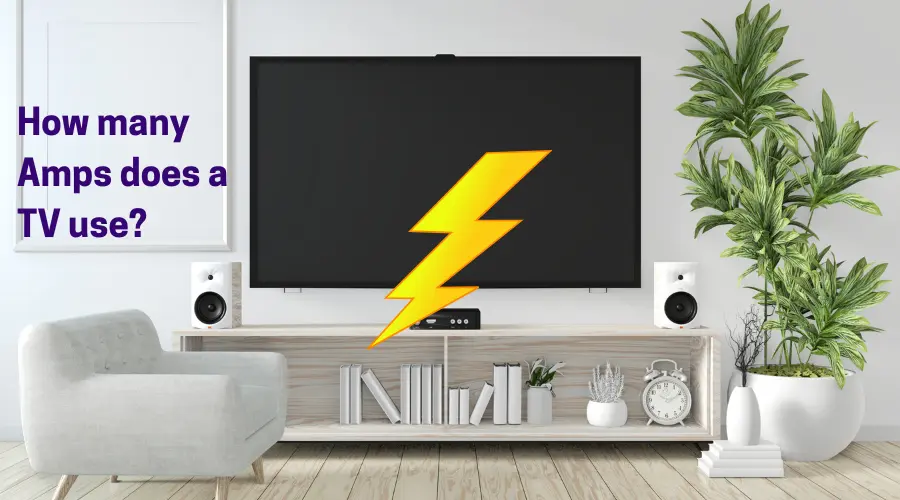When it comes to determining how many amps a TV uses, it’s important to understand that the exact amount of current a TV draws depends on a variety of factors, including the size of the TV, the type of display (e.g. LED, LCD, plasma), and the settings you have chosen (e.g. screen brightness, volume). However, you can get a rough estimate of a TV’s current draw by looking at its power rating, which is typically measured in watts.
Any Electrical appliance like an Air conditioner, Ceiling fan, or Tv set consumes AC power and has a significant amount on your Electricity bill.
In this post, we will delve into the world of energy use of your LCD television or your LED TV. We will also compare the electricity consumption for TV size and panel to give you a better understanding of how your television might be impacting your bills. Also, I will discuss ways you can reduce the energy consumption by your TV.

Let’s get started!
How many Amps does a TV use?
Typically an average Smart TV uses 1.0 Amp per Hour. Depending on the efficiency ratings, screen size, and technology, a 60 inches Smart TV may run higher or lower at times though.
By figuring out the Wattage rating and dividing it by its voltage, will give you the total amp your TV is using. Likewise, a 55-inch flat-screen Modern TV using 150 Watts and 120 Volts will consume 1.25 amp.
For Example, A TV with 116 Watts and Voltage ratings of 120V, uses almost 0.97 amps whereas a 12V TV with 60 Watts with a 19-inch screen has an average of 5 amps.
Know About Ampere
The Amp or Ampere measures the current flowing through the circuit. The energy consumption of a TV is determined by Wattage. The higher devices consume more energy than the lower Wattage devices.
The main energy supply is known as Voltage Supply, which can be 110V &120V or 220V & 230V as well.
The standard voltage rating in the United States is 110V and 220V.
If you want to know the number of amps your TV draws, you can simply use the formula:-
Amp= Watt/Volts.
So, when we measure the Amperage, we actually measure how much is the current draw amount by your Appliance, here it is your TV.
Factors on which the energy consumption of a TV depends
Model, screen size, screen type, and other features of your television should be considered while calculating the average TV ampere. For example, an average 120 Volts & 113 Watts TV will use 0.95 Ampere.
These factors can affect a TV’s energy consumption and some possible ways to reduce energy consumption are shown in the table below:
| Factor | How it can affect energy consumption | Possible ways to reduce energy consumption |
|---|---|---|
| Size of TV | Larger TVs require more energy to operate | Choose a smaller TV |
| Panel Technology used in TV | LED TVs are more energy-efficient than CRT TVs | Choose an LED TV |
| Brightness of screen | A brighter screen requires more energy | Lower the screen brightness |
| Amount of time TV is used | Using the TV for longer periods of time increases energy consumption | Turn off the TV when it is not in use |
Current Drawn in Amp Hour for Smart TVs based on their size
Here are the average power consumptions based on TV sizes represented in the table below:
| TV Size | Current Draw/Hour (Amps per hour) |
|---|---|
| 32 inches | 0.5 – 1.0 |
| 40 inches | 0.7 – 1.2 |
| 50 inches | 1.0 – 1.5 |
| 55 inches | 1.2 – 1.7 |
| 60 inches | 1.5 – 2.0 |
| 65 inches | 1.7 – 2.2 |
| 70 inches | 2.0 – 2.5 |
| 75 inches | 2.2 – 2.7 |
| 80 inches | 2.5 – 3.0 |
Note: The above values are approximations and may vary depending on the specific model and features of the TV. It is always best to refer to the manufacturer’s specifications for accurate information on power consumption.
Analysis: Smart TVs are efficient in consuming power. Although Plasma TVs are great power eaters, LCDs are less in comparison and LEDs prove leaders in efficiency overall.
Current Drawn in Amp Hour for Smart TVs based on panel types
Some popular TV models that determine the Amperage of television:
| Panel Type | Current Draw/Hour (amps per hour) |
|---|---|
| LED | 0.5 – 1.5 |
| LCD | 1.5-2.0 |
| OLED | 0.5 – 1.0 |
| QLED | 0.7 – 1.2 |
| Plasma | 1.5 to 3.0 |
| CRT | 2.0 to 3.0 |
Here are some real examples and current drawn calculations on wattage for different tv panels.
- Tube TVs have the highest energy consumption. It averages 150 Watts for a 32-inch screen and 80 Watts for 19 inches.
- A Plasma TV of 32 inches consumes about 160 Watts of energy. A 32-inch LCD TV has an average of 65-70 Watts. An LED Demands 35 Watts for 24 inches and 41 Watts for a 32-inch screen.
- A 43-inch OLED TV requires 75 Watts on average and 57 Watts for a 32 inches screen.
- A Smart TV consumes 157 Watts on average.
However, an average American television size is a 50 or 51-inch TV set.
Electricity Cost for TVs power usage
| TV Size | TV Type | Power | Cost$/Month | Cost$/Year |
| 32” | LED | 30W | 0.495 | 5.94 |
| 40” | LED | 45W | 0.743 | 8.91 |
| 55” | LED | 70W | 1.155 | 13.86 |
| 55” | Plasma | 200W | 3.300 | 39.60 |
| 55” | OLED | 40W | 0.660 | 7.92 |
| 65” | LED | 90W | 1.485 | 17.82 |
| 65” | Plasma | 300W | 4.950 | 59.40 |
| 65” | OLED | 50W | 0.825 | 9.90 |
To know more about the electricity cost for TV, you can check this post.
How to reduce your TV’s power usage?
Here are a few more tips for reducing your TV’s electricity consumption:
- Use a power strip/surge protector: You can plug your TV and other electronics into a power strip and turn them off(will stop current flow in the TV in its standby mode) when not in use to reduce standby power consumption. This would also act as a circuit breaker and be useful for your TV in case of lightning strikes.
- Set your TV to sleep mode: Most TVs have a sleep mode or power-saving mode that reduces power consumption when the TV is not in use. You can set your TV to automatically turn off after a certain amount of time.
- Choose an Energy Efficient TV: Look for TVs with Energy Star labels, as they are more energy efficient and use less power from the power supply than other TVs.
- Use a Smart TV: Smart TVs have features like automatic power-off and energy-saving modes that can help reduce your TV’s power consumption.
- Use a TV with an LED display: LED TVs use less energy than other types of TVs, so they can help reduce your power consumption.
By following these tips, you can help reduce your TV’s power consumption and save energy.
Conclusion
Let’s conclude the post on how many Amps does a TV use!
So, next time while using a TV you will consider this power consumption and will use your TV wisely. If you have an LED panel you will actually save a lot on electric bills whereas if you use a Plasma TV your Bills would be higher.
I hope you liked reading this article and found this helpful.

I’m Anirban Saha, Founder & Editor of TechBullish. With a B.Tech in Electronics and Communication Engineering, and 6+ years of experience as a software developer, I have expertise in electronics, software development, gadgets, and computer peripherals. I love sharing my knowledge through informational articles, how-to guides, and troubleshooting tips for Peripherals, Smart TVs, Streaming Solutions, and more here. Check Anirban’s Crunchbase Profile here.
